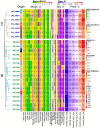Exploring Wild Hordeum spontaneum and Hordeum marinum Accessions as Genetic Resources for Fungal Resistance
- PMID: 37765425
- PMCID: PMC10534467
- DOI: 10.3390/plants12183258
Exploring Wild Hordeum spontaneum and Hordeum marinum Accessions as Genetic Resources for Fungal Resistance
Abstract
Crop Wild Relatives (CWRs), as potential sources of new genetic variants, are being extensively studied to identify genotypes that will be able to confer resistance to biotic stresses. In this study, a collection of barley wild relatives was assessed in the field, and their phenotypic variability was evaluated using a Barley Description List, reflecting the identified ecosites. Overall, the CWRs showed significant field resistance to various fungal diseases. To further investigate their resistance, greenhouse tests were performed, revealing that several CWRs exhibited resistance against Fusarium culmorum, Pyrenophora teres, and Puccinia hordei G.H. Otth. Additionally, to characterize the genetic diversity within the collection, DNA polymorphisms at 21 loci were examined. We successfully employed barley-specific SSR markers, confirming their suitability for identifying H. spontaneum and even H. marinum, i.e., perennial species. The SSR markers efficiently clustered the investigated collection according to species and ecotypes, similarly to the phenotypic assessment. Moreover, SSR markers associated with disease resistance revealed different alleles in comparison to those found in resistant barley cultivars. Overall, our findings highlight that this evaluated collection of CWRs represents a valuable reservoir of genetic variability and resistance genes that can be effectively utilized in breeding programs.
Keywords: FHB; genetic resources; net blotch; resistance breeding; rust; wild barley.
Conflict of interest statement
The authors declare no conflict of interest or property resulting from any ideas, methods, instructions or products referred to in the content.
Figures





Similar articles
-
Haplotype diversity and population structure in cultivated and wild barley evaluated for Fusarium head blight responses.Theor Appl Genet. 2013 Mar;126(3):619-36. doi: 10.1007/s00122-012-2006-4. Epub 2012 Nov 3. Theor Appl Genet. 2013. PMID: 23124391
-
Genome-wide association mapping of Pyrenophora teres f. maculata and Pyrenophora teres f. teres resistance loci utilizing natural Turkish wild and landrace barley populations.G3 (Bethesda). 2021 Oct 19;11(11):jkab269. doi: 10.1093/g3journal/jkab269. G3 (Bethesda). 2021. PMID: 34849783 Free PMC article.
-
Diversity and Sources of Multiple Disease Resistance in Hordeum spontaneum.Plant Dis. 2003 Dec;87(12):1439-1448. doi: 10.1094/PDIS.2003.87.12.1439. Plant Dis. 2003. PMID: 30812385
-
Leaf rust of cultivated barley: pathology and control.Annu Rev Phytopathol. 2015;53:565-89. doi: 10.1146/annurev-phyto-080614-120324. Epub 2015 Jun 5. Annu Rev Phytopathol. 2015. PMID: 26047566 Review.
-
Resistance genes in barley (Hordeum vulgare L.) and their identification with molecular markers.J Appl Genet. 2003;44(3):291-309. J Appl Genet. 2003. PMID: 12923305 Review.
References
-
- Hajjar R., Hodgkin T. The use of wild relatives in crop improvement: A survey of developments over the last 20 years. Euphytica. 2007;156:1–13. doi: 10.1007/s10681-007-9363-0. - DOI
-
- Dempewolf H., Baute G., Anderson J., Kilian B., Smith C., Guarino L. Past and Future Use of Wild Relatives in Crop Breeding Crop Science. 2017. [(accessed on 7 September 2023)]. pp. 1070–1082. Available online: https://acsess.onlinelibrary.wiley.com/doi/abs/10.2135/cropsci2016.10.0885. - DOI
-
- Hajjar R., Hodgkin T. Using crop wild relatives for crop improvement: Trends and perspectives. In: Maxted N.B.V.F., Kell S.P., Iriondo J., Dulloo E., Turok J., editors. Crop Wild Relative Conservation and Use. CABI; Sicily, Italy: 2007. pp. 535–548.
-
- Maxted N., Scholten M., Codd R., Ford-Lloyd B. Creation and use of a national inventory of crop wild relatives. Biol. Conserv. 2007;140:142–159. doi: 10.1016/j.biocon.2007.08.006. - DOI
Grants and funding
LinkOut - more resources
Full Text Sources

